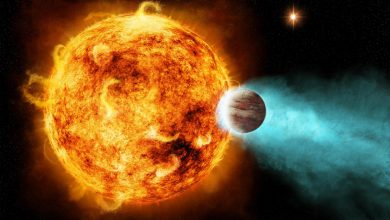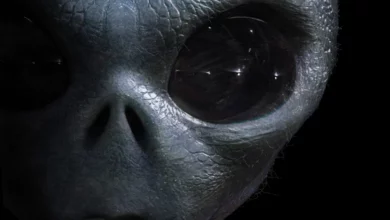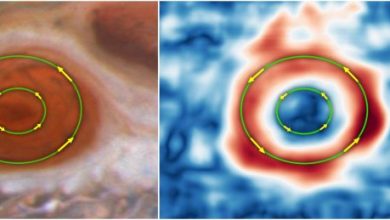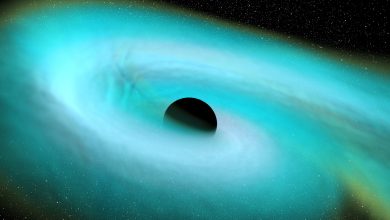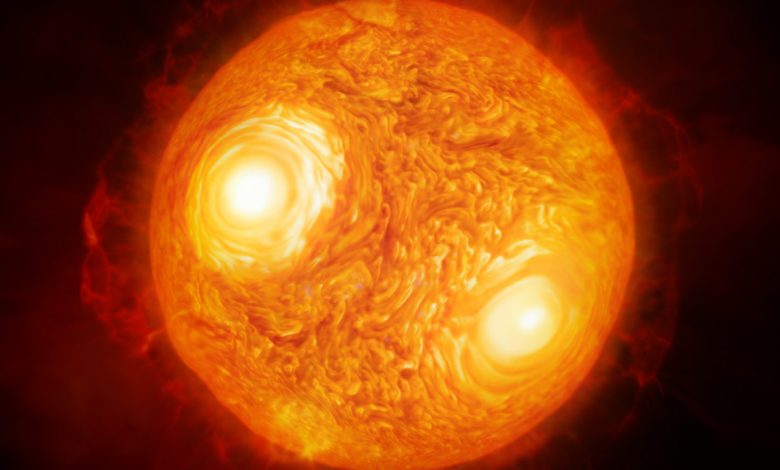
In the southern hemisphere, in the constellation Canis Major, lies a very young, very massive red hypergiant star called VY Canis Majoris (VY CMa).
VY Canis Majoris – in the direction to our constellation Canis Major the Greater Dog – is one of the largest stars known. It’s a red hypergiant, so huge that it makes the famous giant star Betelgeuse look small by comparison. If you replaced our sun with VY Canis Majoris, its outer layers would extend past the orbit of the 5th planet, Jupiter. A pulsating variable, its apparent magnitude (how bright it appears in the night sky) varies unpredictably. It is located 1.2 kiloparsecs, which is about 3,900 light-years, so it only looks like a faint star to us (with telescopes) even though it’s actually as bright as 300,000 suns. It is only 8.2 million years old, and is one of the largest stars known to exist.
Astronomers have wondered about this star, because – like Betelgeuse in late 2019 and early 2020 – it’s known to have faded in brightness. VY Canis Majoris, though, has faded very gradually, over the past couple of centuries. On March 4, 2021, astronomers using the Hubble Space Telescope said they think they know why. They said this aging star is belching out huge clouds of gases, forming dust that is gradually blocking more and more of its light. One of the researchers commented:
VY Canis Majoris is behaving a lot like Betelgeuse on steroids.
The researchers published their peer-reviewed findings on February 4 in The Astronomical Journal.
The red hypergiant VY Canis Majoris is enshrouded in huge clouds of dust
Stars come in an extraordinary range of sizes. One of the most colossal is VY Canis Majoris. It is approximately 1,420 times the radius of the Sun, it is 7-8 AU across (with 1 AU being 149.5 million kilometers — the average distance of Earth to the Sun). If placed in the middle of our solar system it would engulf all the planets out to Saturn’s orbit. It is so far away that, 200 years ago, it could be seen only as a faint star in the winter constellation of the Great Dog. Since then, it has faded and is no longer visible to the naked eye. Astronomers used Hubble to get a close-up look at the star and discovered the reason for the dimming. The star is expelling huge clouds of dust in the final stages of its life. Eventually, the bloated star may explode as a supernova, or may simply collapse and form a black hole.
Stars come in an extraordinary range of sizes. One of the most colossal is VY Canis Majoris. It is approximately 1,420 times the radius of the Sun, it is 7-8 AU across (with 1 AU being 149.5 million kilometers — the average distance of Earth to the Sun). If placed in the middle of our solar system it would engulf all the planets out to Saturn’s orbit. It is so far away that, 200 years ago, it could be seen only as a faint star in the winter constellation of the Great Dog. Since then, it has faded and is no longer visible to the naked eye. Astronomers used Hubble to get a close-up look at the star and discovered the reason for the dimming. The star is expelling huge clouds of dust in the final stages of its life. Eventually, the bloated star may explode as a supernova, or may simply collapse and form a black hole.

So why is this star fascinating?
That largely comes down to the nature of its existence. Large stars like VY CMa have extremely short lifespans on the galactic timescale. At just 8.2 million years old, it will — with near certainty — explode in a supernova event within 100,000 years, with its remnant likely to form a black hole instead of a neutron star.
“I think what really attracts astronomers to these very luminous and active stars, first of all, is their short lifetime,” said Dr. Roberta Humphreys, in an interview with NASASpaceflight on her and her team’s recently published paper, “The Mass-loss History of the Red Hypergiant VY CMa”.
The paper, published in the March 2021 issue of The Astronomical Journal, can be read here.
Last year, astronomers were puzzled when Betelgeuse, the bright red supergiant star in the constellation Orion, dramatically faded, but then recovered. The dimming lasted for weeks. Now, astronomers have turned their sights toward a monster star in the adjoining constellation Canis Major, the Great Dog.
As with Betelgeuse, Hubble data suggest the answer for why this bigger star is dimming. For Betelgeuse, the dimming corresponded to a gaseous outflow that may have formed dust, which briefly obstructed some of Betelgeuse’s light from our view, creating the dimming effect.
“In VY Canis Majoris we see something similar, but on a much larger scale. Massive ejections of material which correspond to its very deep fading, which is probably due to dust that temporarily blocks light from the star,” said Humphreys.
“This star is absolutely amazing. It’s one of the largest stars that we know of—a very evolved, red supergiant. It has had multiple, giant eruptions,” explained Humphreys.
Giant arcs of plasma surround the star at distances from it that are thousands of times farther away than the Earth is from the Sun. These arcs look like the solar prominences from our own Sun, only on a much grander scale. Also, they’re not physically connected to the star, but rather, appear to have been thrown out and are moving away. Some of the other structures close to the star are still relatively compact, looking like little knots and nebulous features.
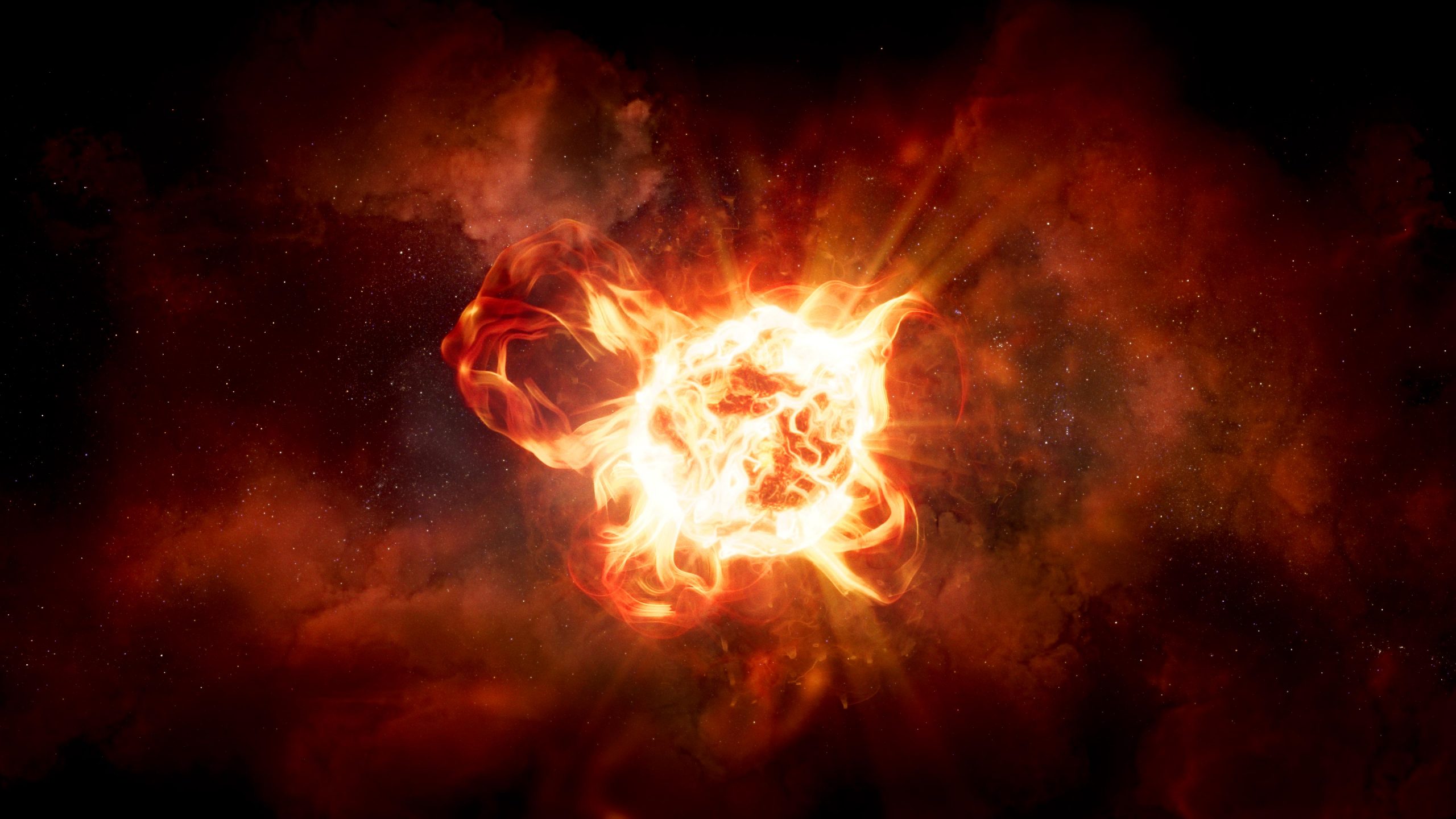
In previous Hubble work, Humphreys and her team were able to determine when these large structures were ejected from the star. They found dates ranging over the past several hundred years, some as recently as the past 100 to 200 years.
Now, in new work with Hubble, researchers resolved features much closer to the star that may be less than a century old. By using Hubble to determine the velocities and motions of the close-in knots of hot gas and other features, Humphreys and her team were able to date these eruptions more accurately. What they found was remarkable: many of these knots link to multiple episodes in the 19th and 20th centuries when VY Canis Majoris faded to one-sixth its usual brightness.
Unlike Betelgeuse, VY Canis Majoris is now too faint to be seen by the naked eye. The star was once visible but has dimmed so much that it can now only be seen with telescopes.
The hypergiant sheds 100 times as much mass as Betelgeuse. The mass in some of the knots is more than twice the mass of Jupiter. “It’s amazing the star can do it,” Humphreys said. “The origin of these high mass-loss episodes in both VY Canis Majoris and Betelgeuse is probably caused by large-scale surface activity, large convective cells like on the Sun. But on VY Canis Majoris, the cells may be as large as the whole Sun or larger.”
“This is probably more common in red supergiants than scientists thought and VY Canis Majoris is an extreme example,” Humphreys continued. “It may even be the main mechanism that’s driving the mass loss, which has always been a bit of a mystery for red supergiants.”
Though other red supergiants are comparably bright and eject a lot of dust, none of them is as complex as VY Canis Majoris. “So what’s special about it? VY Canis Majoris may be in a unique evolutionary state that separates it from the other stars. It’s probably this active over a very short period, maybe only a few thousand years. We’re not going to see many of those around,” said Humphreys.

The star began life as a super-hot, brilliant, blue supergiant star perhaps as much as 35 to 40 times our Sun’s mass. After a few million years, as the hydrogen fusion burning rate in its core changed, the star swelled up to a red supergiant. Humphreys suspects that the star may have briefly returned to a hotter state and then swelled back up to a red supergiant stage.
“Maybe what makes VY Canis Majoris so special, so extreme, with this very complex ejecta, might be that it’s a second-stage red supergiant,” explained Humphreys. VY Canis Majoris may have already shed half of its mass. Rather than exploding as a supernova, it might simply collapse directly to a black hole.
“Believe it or not, we observe changes in stars over a human lifetime. If you look at the history of VY Canis Majoris and its high mass-loss episodes, this is stuff occurring on the timescale of a human life.”
These high mass-loss events referenced by Dr. Humphreys form the crux of her and her team’s recent work, which examined the knots, clumps, and extended arcs of ejecta material that surround VY CMa.
By closely investigating these areas around the star, Humphreys et al. were able to correlate some of the ejecta plumes, clumps, and knots with dimming events recorded in the star’s 320 year observational period dating back to 1801.
According to the team’s results, “We find probable correlations of two to three separate mass ejections or outflows with the 19th century episode and with the 1920-1940 period suggesting that each of the minima may be related to a separate outflow.”
To properly understand this result, we must go back through the observational history of VY CMa.
The first (surviving) observation in 1801 gave the star an apparent magnitude just at or near +6.5 — barely (depending on atmospheric conditions) visible to the naked eye. This was calculated by eye, and photographic plates to confirm the apparent magnitude did not exist at the time.
Other recorded observations from 1830 and a cluster around 1848-1850 returned similar +6.5 apparent magnitude observations — with even a few estimates closer to +6, indicating a potential, slight brightening of the star.
(It’s important to note this could be due to local atmospheric and telescopic conditions during observations.)
A 20 year gap into the early 1870s then exists. But it’s in the 1870s data that things really start to get interesting. Huge swings in apparent magnitude appear, rapid fluctuations from +6.5 down to +8 (too faint to be seen with the naked eye).
These wide swings continued throughout the 1870s. But after each major dimming event, VY Canis Majoris returned more or less to an apparent magnitude of +6.5.
✔️ MYSTERY SOLVED: Like red supergiant star Betelgeuse, astronomers sought to explain why red hypergiant VY Canis Majoris varied in brightness. We now understand why, thanks to @NASAHubble: https://t.co/ND4wmdhm1T pic.twitter.com/Q72zIj7F2V
— NASA (@NASA) March 4, 2021
Observations in the 1880s showed a potentially steady apparent magnitude of +7.3, but records are sparse. By the 1890s, near continuous observation of the star began. And two big things stand out in the data:
- VY CMa never recovered in apparent magnitude from a event that’s light signature would have reached Earth between 1880 and 1888 (but was apparently not directly observed at the time), and
- Since that 1880s event, the star has maintained a maximum apparent magnitude between +7.5 and +8 — recovering to this point after each major dimming event in the 1900s, with no deep minima events yet observed in the 2000s.
So what has caused all these dimming events? What happened in the 1880s that caused the star to not recover as it has from every other dimming event? And don’t these dimming and brightening events sound familiar in terms of Betelgeuse’s dimming surprise of 2019/2020?
We shall return to the question of Betelgeuse later.
But first, to understand the observed dimming events of VY Canis Majoris, we must look at the clumps, knots, and arcs of ejecta material at the heart of Humphreys et al.’s recent work.
“Imaging and spectroscopy of the knots, clumps, and extended arcs in the complex ejecta of VY CMa confirm a record of high mass-loss events over the past few hundred years,” note Humphreys et al. in their paper. “Hubble Space Telescope/Space Telescope Imaging Spectrograph spectroscopy of numerous small knots close to the star allow us to measure their radial velocities from the strong K I emission and determine their separate motions, spatial orientations, and time since ejecta.”
“Their ages concentrate around 70, 120, 200, and 250 yr ago. … Comparison with VY CMa’s historic light curve from 1800 to the present shows several knots with ejection times that correspond with extended periods of variability and deep minima.”
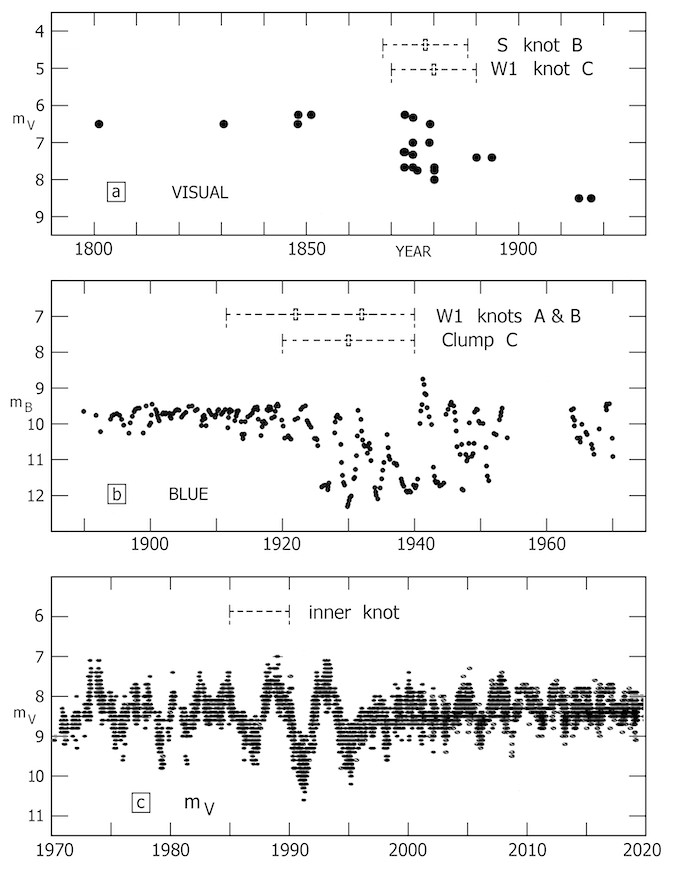
As seen in the above image, the inner knot, which is estimated to have been ejected from VY CMa 30-35 years ago (light time received at Earth) corresponds to the 1987 and 1992 dimming events. Likewise, the S knot B and W1 knot C’s calculated ejection times overlap with each other and correspond to the 1870s dimming events (and are likely linked in terms of time of ejection to the major event from which VY CMa has not visually recovered in apparent magnitude).
W1 knots A&B and Clump C have calculated ejection times that correspond to the successive and deep minima events from the 1920s to the 1940s.
What’s more, these clumps, knots, and ejecta plumes are massive themselves — some on the order of 10 times the average annual mass loss of VY Canis Majoris, which is calculated at the exceedingly high rate of 6×10−4 M☉(solar masses) per year.
“These large ejections, one of these knots or clumps, is 10 times [the star’s annual average loss]. This is how it is doing it. For VY, you arrive at that [high] average annual mass-loss rate because of these massive events that occur.”
As the ejection events begin, a large cloud of material is violently thrown from the star — blocking some of its light from reaching Earth. The greater the event in terms of material, the more significant the dimming event appears.
The speed at which the material travels away from the star, calculated to be between 20-30 km/s−1, causes the material to quickly move out of the direct line of sight to VY CMa — thus explaining why the star dims and then recovers to its previous apparent magnitude.
So then what happened in the 1880s that caused the star to not recover as it has from every other dimming event?
“Unfortunately, I think given the incompleteness of the data of the 19th century, we can’t really pin it down. Sometime between about 1880 and 1890, [VY CMa] had an outflow, an ejection that ended up more permanently obscuring the star,” noted Dr. Humphreys.
“Maybe this was an ejection that was more nearly in our line of sight, and it hasn’t moved out of our line of sight yet and maybe it won’t for quite some time.”
As Humphreys et al. noted in their paper, “The most interesting period may be 1870-1880 and the post-1880 fading from which VY CMa has not recovered. S knot B and W1 knot C plus possibly the W2 knot have ejection ages that correspond to this period. Their different locations and orientations with respect to the star suggest that surface activity occurred over much of the star with separate outflows in different directions lasting at least 10 years. The major dimming of the star after 1880 by one or more magnitudes is very likely the origin of the present obscuration of the central star.”
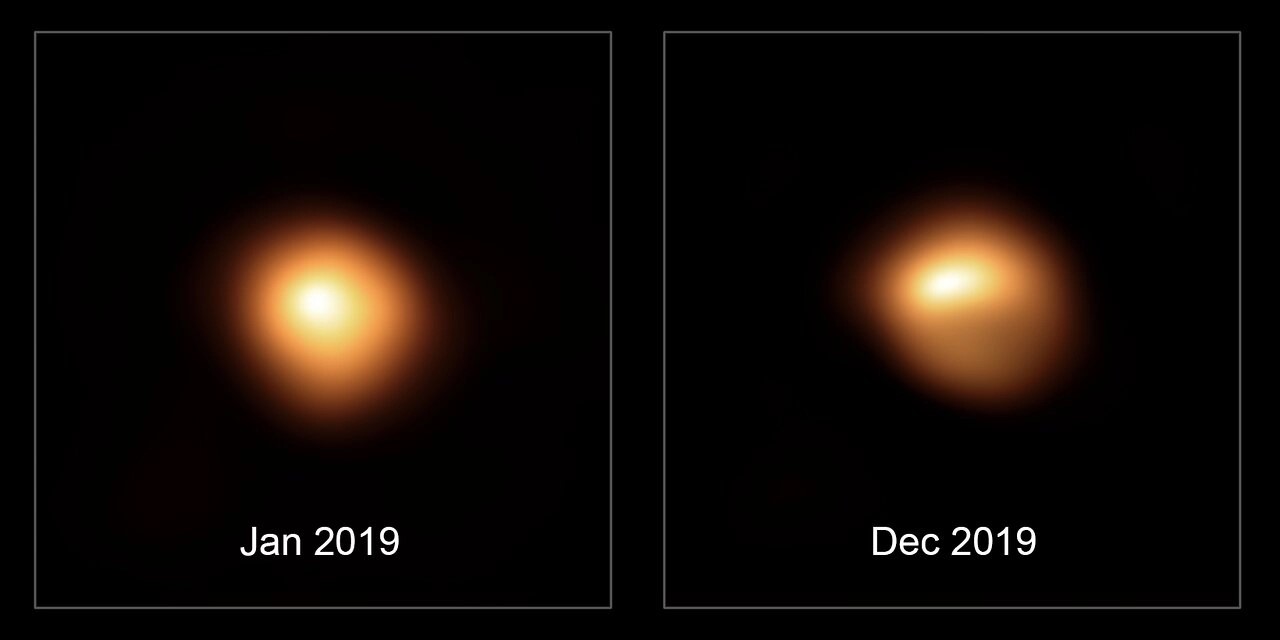
So then how does this all relate to Betelgeuse? Much attention was given to the star from October 2019 to February 2020 when the usually reliable, semiregular variable star (which usually fluctuates in apparent magnitude from just +0 and +0.5 over predictable 425 day and 5.9 year cycles) suddenly, rapidly, and unexpectedly dimmed to a minimum of +1.614.
Images of the star at the time showed nearly its entire southern hemisphere significantly obscured.
While rampant speculation of an impending supernova spread through popular culture, this is where Betelgeuse’s similarities to VY Canis Majoris come into play. Both are short-lived red giants. Both are approximately 8.0-8.5 million years old (with that being Betelgeuse’s predicted age while VY CMa has an estimated age of 8.2 million years).
Thus, what is happening with VY Canis Majoris and its large-scale ejection events can shed light on what is happening with Betelgeuse. And in fact, a recent paper published by Dupre et al., focusing on the Betelgeuse dimming event, concluded that a major ejection event occurred on the star — obstructing much of the light from the star’s southern hemisphere until it traveled out of our line of sight, causing an increase in brightness.
“The outflows from VY, it’s the same that we’re saying with Betelgeuse,” related Dr. Humphreys. “But with Betelgeuse, it’s much more extreme and on a bigger scale. Question is: is Betelgeuse going to do it again? Is it now entering an active period for some reason?”
And this would make sense given that both Betelgeuse and VY Canis Majoris are predicted to go supernova within 100,000 years. While VY Canis Majoris is more active in its mass-loss events than Betelgeuse has now been observed to have gone through, this type of behavior from red hypergiants and red supergiants are common.
“It’s quite possible this is a stage that the star goes through when it’s, say, getting near the end of its life. We seem to have evidence that allows these massive stars of different types to have high mass-loss episodes that we think precede the terminal state,” said Dr. Humphreys.
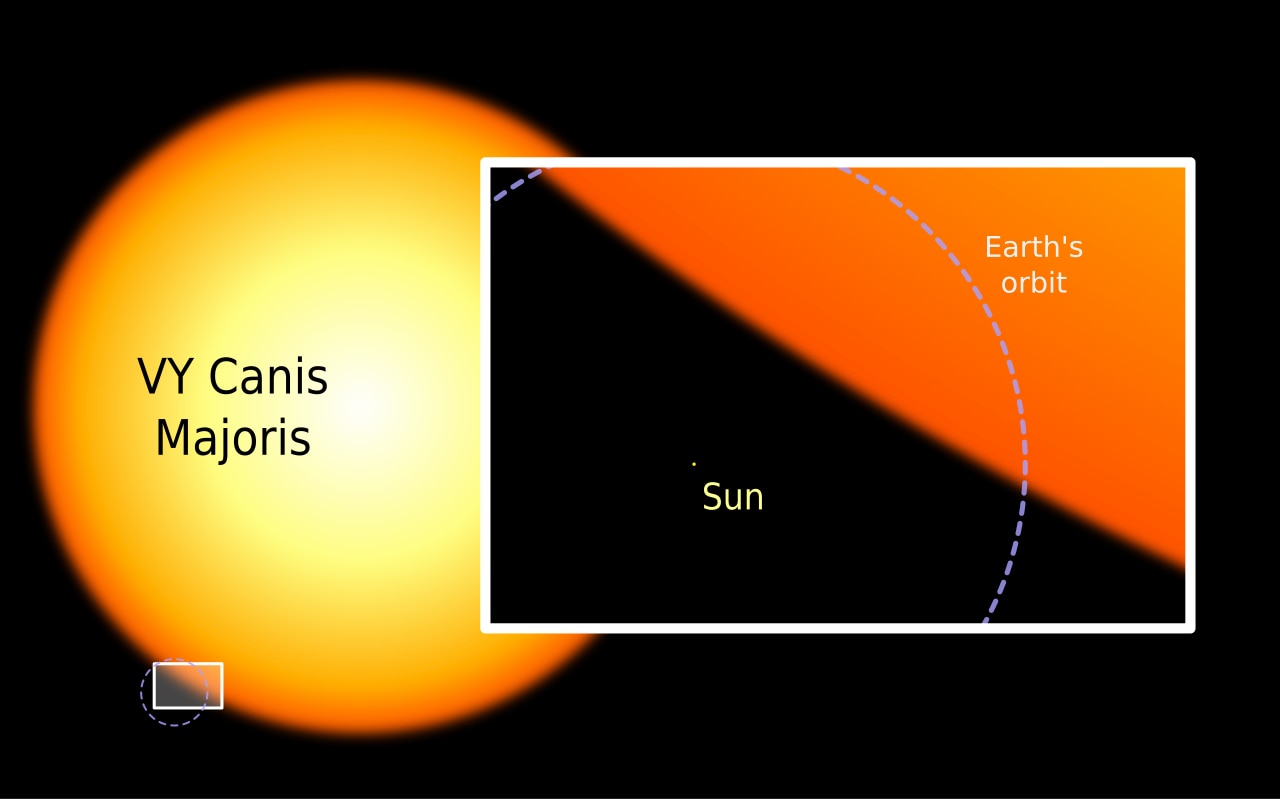
While VY Canis Majoris cannot be seen without telescopic aid, its proximity to Earth makes it a prime target for understanding the late-stage evolution of red hypergiants — and by extension similar red supergiant stars like Betelgeuse.
Both stars are well known for various reasons, and both will provide spectacular end-of-life light shows on Earth when they go supernova. It’s possible that what is being seen with VY Canis Majoris right now is the star proceeding through the final phase of its evolution before the terminal period begins. If so, it could provide clues on what to expect from Betelgeuse as it too races toward the end of its brief celestial existence.
But these high mass-loss events from two nearby giants do not simply serve as end of life indicators or explanations for VY Canis Majoris and Betelgeuse’s dimming events — they are life-giving eruptive forces to the universe as well.
“What’s important about them, even though they seem relatively rare, is that these are some of the main supergiants, massive stars, the main contributors of much of what we call the interstellar medium,” said Dr. Humphreys.
And those all form the building blocks for more complex solar systems that give rise to gas, ice, and terrestrial planets around long-lived, stable stars, with planets and moons that could well harbor life.

